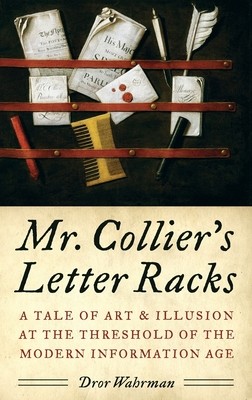
- We will send in 10–14 business days.
- Author: Dror Wahrman
- Publisher: Oxford University Press, USA
- ISBN-10: 0199738866
- ISBN-13: 9780199738861
- Format: 16.8 x 23.6 x 2.3 cm, hardcover
- Language: English
- SAVE -10% with code: EXTRA
Reviews
Description
Three hundred years ago, an unprecedented explosion in inexpensive, disposable print--newspapers, pamphlets, informational publications, artistic prints--ushered in a media revolution that forever changed our relationship to information. One unusually perceptive man, an obscure Dutch/British still life painter named Edward Collier, understood the full significance of these momentous changes and embedded in his work secret warnings about the inescapable slippages between author and print, meaning and text, viewer and canvas, perception and reality.
Working around 1700, Collier has been neglected, even forgotten, precisely because his secret messages have never been noticed, let alone understood. Until now. In Mr. Collier's Letter Racks, Dror Wahrman recovers the tale of an extraordinary illusionist artist who engaged in a wholly original way with a major transformation of his generation. Wahrman shows how Collier developed a hidden language within his illusionist paintings--replete with minutely coded messages, witty games, intricate allusions, and private jokes--to draw attention to the potential and the pitfalls of this new information age. A remarkably shrewd and prescient commentator on the changes unfolding around him, not least the advent of a new kind of politics following the Glorious Revolution, Collier performed a post-modernist critique of modernity long before the modern age. His trompe l'oeil paintings are filled with seemingly disconnected, enigmatic objects--letters, seals, texts of speeches, magnifying glasses,title pages--and with teasingly significant details that require the viewer to lean in and peer closely. Wahrman does just that, taking on the role of detective/cultural historian to unravel the layers of deceptions contained within Collier's extraordinary paintings. Written with passionate enthusiasm and including more than 70 color illustrations, Mr. Collier's Letter Racks is a spell-binding feat of cultural history, illuminating not only the work of an eccentric genius but the media revolution of his period, the birth of modern politics, and the nature of art itself.
EXTRA 10 % discount with code: EXTRA
The promotion ends in 18d.00:47:36
The discount code is valid when purchasing from 10 €. Discounts do not stack.
- Author: Dror Wahrman
- Publisher: Oxford University Press, USA
- ISBN-10: 0199738866
- ISBN-13: 9780199738861
- Format: 16.8 x 23.6 x 2.3 cm, hardcover
- Language: English English
Three hundred years ago, an unprecedented explosion in inexpensive, disposable print--newspapers, pamphlets, informational publications, artistic prints--ushered in a media revolution that forever changed our relationship to information. One unusually perceptive man, an obscure Dutch/British still life painter named Edward Collier, understood the full significance of these momentous changes and embedded in his work secret warnings about the inescapable slippages between author and print, meaning and text, viewer and canvas, perception and reality.
Working around 1700, Collier has been neglected, even forgotten, precisely because his secret messages have never been noticed, let alone understood. Until now. In Mr. Collier's Letter Racks, Dror Wahrman recovers the tale of an extraordinary illusionist artist who engaged in a wholly original way with a major transformation of his generation. Wahrman shows how Collier developed a hidden language within his illusionist paintings--replete with minutely coded messages, witty games, intricate allusions, and private jokes--to draw attention to the potential and the pitfalls of this new information age. A remarkably shrewd and prescient commentator on the changes unfolding around him, not least the advent of a new kind of politics following the Glorious Revolution, Collier performed a post-modernist critique of modernity long before the modern age. His trompe l'oeil paintings are filled with seemingly disconnected, enigmatic objects--letters, seals, texts of speeches, magnifying glasses,title pages--and with teasingly significant details that require the viewer to lean in and peer closely. Wahrman does just that, taking on the role of detective/cultural historian to unravel the layers of deceptions contained within Collier's extraordinary paintings. Written with passionate enthusiasm and including more than 70 color illustrations, Mr. Collier's Letter Racks is a spell-binding feat of cultural history, illuminating not only the work of an eccentric genius but the media revolution of his period, the birth of modern politics, and the nature of art itself.


Reviews